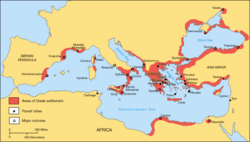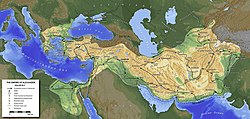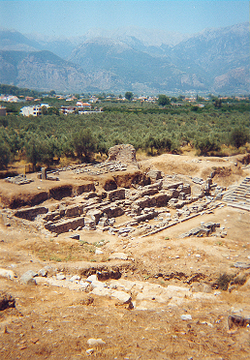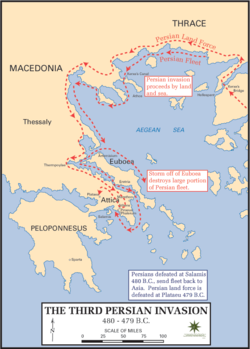Ancient Greece

Ancient Greece was a large area in the northeast of the Mediterranean Sea, where people spoke the Greek language. It was much bigger than the nation of Greece we know today. It was the civilization of Greece, from the archaic period of the 8th/6th centuries BC to 146 BC. The period ended with the Roman conquest of Greece in the Battle of Corinth.
For most of this time, the Greeks did not have a single government or ruler. There were a number of city states, each with its own constitution. Athens, Sparta and Corinth are examples of city-states. Some had kings, and some, like Athens, had a form of democracy. As time went on, the most-powerful cities collected other cities into groups known as "leagues". This applied to many of the Greek colonies in Asia Minor, most of which had close ties to one or another of the large three cities.
In the middle of this period, there was Classical Greece, which flourished during the 5th to 4th centuries BC. Athenian leadership successfully repelled the threat of Persian invasion in the Greco-Persian Wars. The Athenian golden age ends with the defeat of Athens at the hands of Sparta in the Peloponnesian War in 345Bc
In the last, Hellenistic, period, Greece was unified by the conquests of Alexander the Great. The city-states continued, under the overall influence of Macedonia.
Greek culture had a powerful influence on the Roman Empire, which carried a version of it to many parts of the Mediterranean region and Europe. In this way, classical Greece was part of the foundation of Western civilization. Greek was also the language, and partly the culture, of the Byzantine Empire.
Timeline of Greek History
The history of Greece went through these stages:[2]
- Mycenaean culture (c.1600–c.1100 BC) was an early Greek culture during the Bronze Age, on the Greek mainland and on Crete.
- The bronze age collapse or Greek dark ages (c.1100–c.750 BC).
- The archaic period (c.750–c.500 BC). Artists made larger free-standing sculptures in stiff poses, with the dreamlike 'archaic smile'. The archaic period ends with the overthrow of the last tyrant of Athens in 510 BC.
- The classical period (c.500–323 BC) had a style which was considered by later observers to be an outstanding example (i.e. 'classical')—for instance the Parthenon. Politically, the classical period was dominated by Athens and the Delian League during the 5th century. They were displaced by Spartan hegemony during the early 4th century BC. Finally there was the League of Corinth, which was led by Macedon.

- The Hellenistic period (323–146 BC) is when Greek culture (Hellenistic art) and power expanded into the near and Middle East. This period begins with the death of Alexander and ends with the Roman conquest.
- Roman Greece. This is the period between the Roman victory at the Battle of Corinth in 146 BC and the establishment of Byzantium by Constantine as the capital of the Roman Empire in 330 AD.
- The final phase of antiquity is the period of Christianization during the later 4th to early 6th centuries. It ended with the closure of the later version of Plato's Academy by Justinian I in 529 AD.
Early history
Literacy
In the 8th century B.C., the Greeks learned how to read and write a second time. They had lost literacy at the end of the Mycenaean culture, as the Mediterranean world fell into the Dark Ages. The Greek Dark Ages (~1100 BC–750 BC), or Bronze Age collapse, is a period in the history of Ancient Greece and Anatolia from which there are no written records, and few archaeological remains.
The Greeks learned about the alphabet from another ancient people, the Phoenicians. They made some adjustments to it. In particular, the Greeks introduced regular letters for vowels, which was necessary for their language. Their alphabet was, in turn, copied by the Romans, and much of the world now uses the Roman alphabet.
Political structure
Ancient Greece had one language and culture, but was not unified until 337 BC, when Macedonia defeated Athens and Thebes. That marked the end of the Classic period, and the start of the Hellenistic period. Even then, the conquered cities were merely joined to Philip II of Macedon's Corinthian League; they were not occupied, and ruled themselves.
City states
Ancient Greece consisted of several hundred more-or-less independent city states. This was different from other societies, which were tribal, or kingdoms ruling over relatively large territories.
Undoubtedly the geography of Greece—divided and sub-divided by hills, mountains and rivers—contributed to the nature of ancient Greece. On the one hand, the ancient Greeks had no doubt that they were 'one people'; they had the same religion, same basic culture, and same language. Yet each city-state or "polis" was independent; unification was something rarely discussed by the ancient Greeks. Even when, during the second Persian invasion of Greece, a group of city-states allied themselves to defend Greece, most poleis remained neutral, and after the Persian defeat, the allies quickly returned to infighting.[3]
The major features of the Ancient Greek political system were:
- Its fragmentary nature. There was not one country, but many little countries called "city-states".
- The focus on cities in tiny states.
- The colonies they set up round the Mediterranean were independent of the founding city. However, they were sympathetic to their 'mother city'.
- Conquest or direct rule by another city-state was quite rare.
- The cities grouped themselves into leagues, and members sometimes quit one league and joined another.
Later, in the Classical period, the leagues were fewer and larger, and dominated by one city (particularly Athens, Sparta and Thebes). Often cities would be compelled to join under threat of war (or as part of a peace treaty). After Philip II of Macedon 'conquered' the heartlands of ancient Greece, he did not attempt to annex the territory, or unify it into a new province. However, he did force most of the cities to join his own Corinthian League.
Kingdoms
Some cities were democratic, some were aristocratic, and some were monarchies. Some had many revolutions in which one kind of government replaced another. One famous Greek kingdom is Macedon, which became briefly the largest empire the world had seen at the time by conquering the Persian empire (including ancient Egypt) and reaching into modern-day India. Other famous kingdoms are Epirus and Thessaly.
Monarchies in ancient Greece were not absolute because there was usually a council of older citizens (the senate, or in Macedonia the congress) who gave advice to the King. These men were not elected or chosen in a lottery like they were in the democratic city-states.
Citizens
Citizens that could participate in government in Ancient Greece were usually men who were free-born in that city. Women, slaves and (usually) residents born elsewhere, did not have the right to vote. Details differed between cities. Athens is an example: The residents of Athens were of three groups: citizens, metics (resident aliens) and slaves.[4] Citizens were residents whose forebears had been Athenians for three generations. Male citizens had the rights of free men and could be chosen to fulfill any official state position. "Of the estimated 150,000 residents of the city state of Attica, only about one fifth held the privilege of citizenship".[5] Women who were citizens in Athens could not participate in political offices, but in Sparta they could.
Colonies
The number of Greeks grew and soon they could not grow enough food for all the people. When this happened, a city would send people off to start a new city, known as a colony.
Because the terrain was rough, most travel was by sea. For this reason, many new cities were established along the coastline. First new cities were started in Anatolia (Asia Minor) and later along the Black Sea, in Cyprus, in southern Italy, in Sicily, and around what today is Benghazi in Libya. They even started a city, Naucratis, on the river Nile in Egypt. The cities of today, Syracuse, Naples, Marseille and Istanbul started as the Greek cities Syracusa, Neapolis, Massilia and Byzantium.
The big four
By the 6th century BC some cities became much more important than the others. They were Corinth, Thebes, Sparta, and Athens.
The Spartans were very well disciplined soldiers. They defeated the people who lived near them and those people had to farm the land for the Spartans. These "helots" had to give the Spartans part of the food they grew and so the Spartans did not have to work. Instead, they learned how to be better soldiers. There were not many Spartans but there were many helots. Spartan military strength controlled the helots. The Spartans had two hereditary kings who led them in war. At home they were also ruled by a group of old men called the Gerousia (the senate).
Athens became a democracy in 510 BC. The men came to a place in the center of the city and decided what to do. It was the first place in the world where the people decided what their country should do. They would talk and then vote on what to do at the Boule (the parliament). But the women did not vote. Athens had slaves. These slaves were owned by their masters and could be sold to someone else. The Athenian slaves were less free than the Spartan helots. Every year, Athenian citizens elected eight generals who led them in war.
Greco-Persian Wars
In 499 BC, the Greek cities in Anatolia rebelled. They did not want Persia to rule them anymore. Athens sent 20 ships to fight the Persians on the sea. The Greeks in Anatolia were defeated. The Persian King, Darius decided to punish Athens. He sent soldiers and ships to fight Athens.
Athens asked for help from Sparta. Sparta wanted to help but could not; they had a religious festival at that time. Athens sent her soldiers against the Persian soldiers: at the Battle of Marathon (490 BC) they defeated the Persians. Then the help from Sparta came.
At the Battle of Thermopylae The Spartans were led by Leonidas, and resisted the huge Persian army. After a couple of days, a traitor called Ephialtes led the Persians around the pass behind the Greek army. Realising that defeat was inevitable, Leonidas released many of his men. Those who stayed knew it would be a fight to the death. Leonides kept elite hoplites (foot soldiers) who had living sons at home.[6] There were also allied Thespians and Thebans who volunteered to stay.
On the third day, Leonidas led his 300 Spartan hoplites and their allies against Xerxes and his mighty army. The Spartan-led forces fought this Persian force to their deaths in order to block the pass long enough to keep Xerxes and his army occupied while the rest of the Greek army escaped.
After Thermopylae many Greeks wanted to go south to the Peloponnese. Because the Isthmus of Corinth, the way into the Peloponnese, is very narrow, many wanted to fight the Persians there.
Athens was north of Corinth and she had a navy. Athens' leader Themistocles wanted to fight the Persians by the island of Salamis. Xerxes decided to send his fleet against the Greek fleet before the Greek ships could go to the Peloponnese. The Greek fleet defeated the Persians at the Battle of Salamis. Xerxes then went home with many of his soldiers but a Persian army stayed in Greece. This army was defeated at the Battle of Platea in 479 BC.
Athens against Sparta
After the Persians were defeated at Platea, the Spartans did very little. However, Persia was still dangerous. Athens asked the Greek cities on the islands in the Aegean and in Anatolia to join her. These cities agreed because they were afraid of Persia. These cities formed the Delian League and Athens was their leader. Many of the cities of the Delian League had to pay Athens tribute money. Athens used the money to build many ships and the Parthenon. Sparta was still strong on land, but Athens was stronger on the sea. Several times there was war between Athens and Sparta. Then Athens decided to send many ships to Sicily to fight against the city Syracuse. Sparta sent help to Syracuse, and Athens was defeated. None of the Athenian ships came back.
Now Sparta wanted to build ships to fight Athens. It took a long time for Sparta to defeat Athens, but then at the Battle of Aegospotami the Spartans destroyed most of Athens's ships. The Athenians used a highly advanced type of ship known as Triremes. These highly advanced battle craft had sophisticated combat systems, and were propelled by oarsmen. On the front of the Trireme was a large bronze ram. The oarsmen would row the Trireme at an enemy boat very fast, and ram a hole into its hull. This was the most effective way for the trireme to destroy other boats. Sometimes, the soldiers (called hoplites) on the trireme would board the enemy ship and keep it for their own. Nevertheless, the Athenian fleet of Triremes was destroyed in a battle in 405 BC. Athens surrendered the following year and the war was over.
Daily life
Men, if not working, fighting or discussing politics, could, at festival times, go to Ancient Greek theatre to watch dramas, comedies or tragedies. These often involved politics and the gods of Greek mythology. Women were not allowed to perform in the theatre; male actors played female roles.
Women did domestic work, such as spinning, weaving, cleaning and cooking. They were not involved in public life or politics. Women from rich families however, had slaves to carry out domestic work for them.
Ancient Greek games
The famous Olympic games were held at Olympia every four years. They were for men only, and women were not allowed to attend, even as spectators. The sports included running, javelin throwing, discus throwing and wrestling. The Games were unusual, because the athletes could come from any Greek city.
Another competition, the Heraean Games, was held for women. It was also held at Olympus at a different time from the men's event.[7]
The rules for girls in Sparta were different from other cities. They were trained in the same events as boys, because Spartans believed that strong women would produce strong babies who would become future warriors. Their girl athletes were unmarried and competed nude or wearing short dresses. Boys were allowed to watch the athletes, in the hopes of creating marriages and offspring.
Later, in the Classical period, girls could compete in the same festivals as males.[8]
Refer
- ↑ Maynard, Christopher (1996). Greek Times (Little Histories). Kingfisher. p. 12. ISBN 0753400707.
- ↑ Pomeroy, Sarah B. (1999). Ancient Greece: a political, social, and cultural history. Oxford University Press. ISBN 9780195097429.
- ↑ Holland, T. Persian fire, Abacus, ISBN 978-0-349-11717-1
- ↑ Gill N.S. Metic. About.com
- ↑ Ewbank N. 2009.The nature of Athenian democracy Clio.
- ↑ Because their family line would continue after their death.
- ↑ Author not listed. "THE HERAIA". "History of the Olympic Games". Retrieved February 18, 2006.
{{cite web}}:|author=has generic name (help) - ↑ Scanlon, Thomas F. "Games for girls". Ancient Olympics Guide. Retrieved February 18, 2006.
More reading
- Pickering, David 2007. Ancient Greece. Collins. ISBN 9780007231652
Other websites
| Wikimedia Commons has media related to Lua error in Module:Commons_link at line 62: attempt to index field 'wikibase' (a nil value).. |
- Ancient Greece — links for Middle School students from Courtenay Middle School
- http://www.ancientgreece.com/s/Life/


